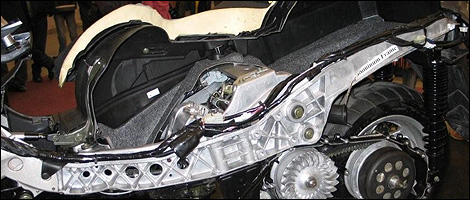The scooter has regained popularity over the past few years. The rising price of fuel is one of the main factors behind the trend. However, importers had seen it coming, and today they offer extensive lineups on the Canadian market.
Small and medium-sized scooters have been available for over twenty years, such as 50, 125 and 150-cc models. Today, scooter importers offer larger models like the Suzuki Burgman 650 Exec, the 582-cc Honda Silver Wing and the all-new 495-cc 2009 Yamaha TMAX. Many other Asian newcomers seem to want to emulate them. According to rumour, in fact, Bombardier might be about to launch a scooter featuring nearly 600 cubic inches of displacement.
Which brings us to this introduction to the scooter. Even though it features many of the same mechanisms and current innovations of the motorcycle, the scooter is still unique in several different ways.
 |
| Aluminum alloy frame |
The frameThe frame is quite special. Most often it's made of tubular steel sections or a seamless steel shell, and both types can be combined. However, some frames are made of extruded aluminum alloy containing a cast iron alloy to reinforce the linking points of the engine or steering column mount, for example. This type of frame is lighter and stronger, and obviously more expensive than the steel type.
Why choose a light alloy frame? Because it's lighter, stronger and resists corrosion better. The frame is dressed up with state-of-the-art mechanical components such as fuel injection systems, complete brake systems, ABS, adjustable suspensions and large wheels.
The transmissionThese days, scooters mostly use continuously variable transmissions (CVT). This system offers the best compromise for a weight/power ratio as well as a very simple driving experience, as it eliminates the need to change gears. This transmission works according to the same principle as that of the snowmobile or ATV, with one small exception: a final gearbox gears down to send the power to the rear wheel.
Some old scooters dating from WWII to the 1970s use a mechanical transmission controlled by the left hand on the handlebars, where cables activate the shifting mechanism. A shifter is located on the left-side grip, which requires a certain amount of nifty wrist and finger action. You have to pull on the shifter while turning the grip forward or backward. The system is more or less the same as the one found on motorcycles, without the foot-activated shifter.
The transmission requires periodic maintenance according to a calendar established by the manufacturer. The driving belt and centrifugal clutch should be checked regularly. It's important that the transmission housing be tight. Water seepage can damage the belt and the internal components.

